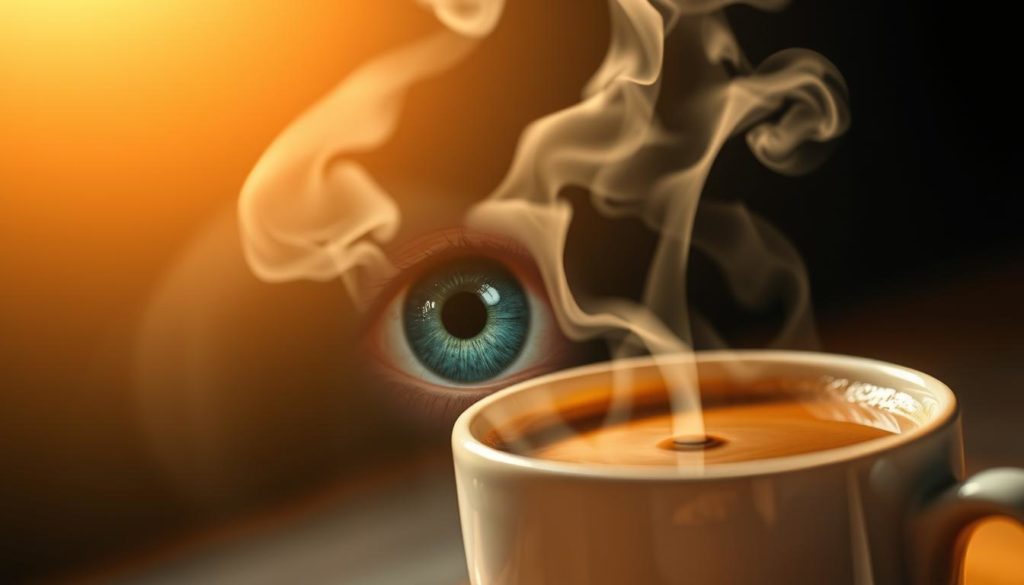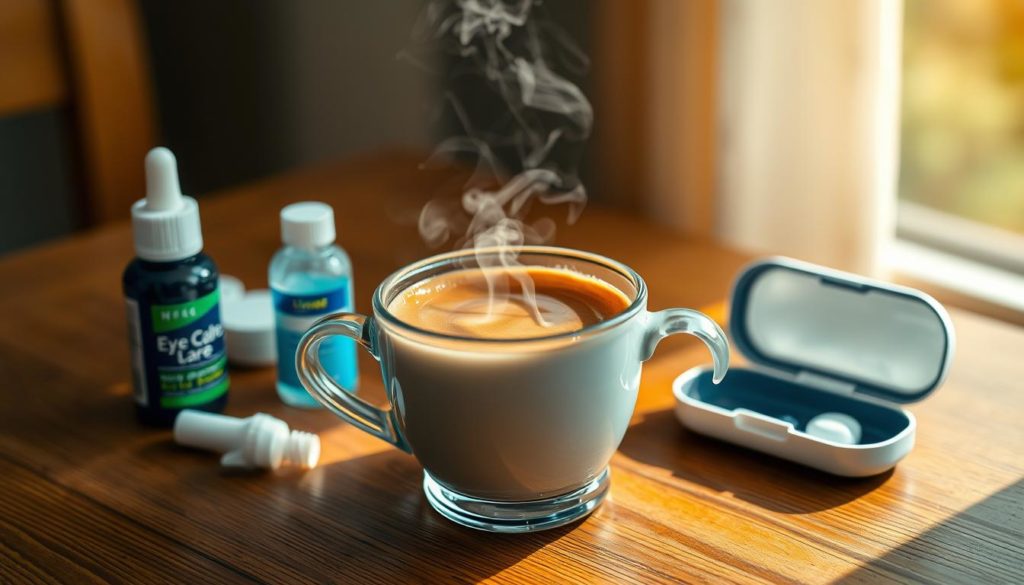Over 16 million Americans deal with dry eye syndrome. As a coffee-loving nation, it’s key to know how caffeine affects dry eyes. This knowledge could improve our lives.
We’ll look at how caffeine might help or hurt people with dry eyes. Caffeine can boost tear production, which might help. But, it can also make the body lose water, which might worsen eye dryness. We’ll use personal stories and studies to get a full picture of the issue.
If you love your daily espresso or think about drinking less coffee, this article has tips for you. It will help you handle dry eye better.
Introduction to Caffeine and Eye Health
Caffeine is a big part of many people’s daily lives because it keeps us awake. But, there’s growing interest in how caffeine affects our eyes, especially with dryness. Many of us are curious if our go-to energy booster impacts our eye health.
Research has looked into caffeine’s roles in eye health, including studies on caffeinated eye drops for dry eyes. This shows both the good and bad sides of caffeine’s effects on dry eyes.

Understanding caffeine and eye health is tricky. Caffeine has antioxidants that may help our eyes. But, too much caffeine might lead to dry eye problems. It’s important to know these two sides when talking about caffeine and eye health.
With so many people using caffeine daily, it’s key to know how it affects eye health. This includes drinking caffeinated drinks or using caffeinated eye drops. We need to carefully look into caffeine’s impact on dry eye and eye health in general.
The Link Between Caffeine and Dry Eye
Experts and everyday people have long discussed how caffeine affects dry eyes. Previously, many thought that caffeine could make dry eye symptoms worse by causing dehydration. However, recent research tells us something different.

Studies now show caffeine might help with tear production. For example, the Women’s Health Study saw that drinking more coffee could lessen the risk of dry eye syndrome. This finding goes against the old belief that caffeine, by making you pee more, could dry out your eyes.
To really grasp how caffeine affects dry eyes, we need to dive into the science behind it. Even though it might seem odd, the way caffeine perks up tear glands is quite promising for managing dry eye.
Here are the highlights from the latest studies:
| Study | Key Findings |
|---|---|
| Women’s Health Study | Reduced risk of dry eye with higher caffeine consumption. |
| Investigative Ophthalmology Report | Stimulation of tear production observed in controlled caffeine intake. |
How Caffeine Affects Tear Production
Researchers are paying a lot of attention to caffeine’s role in making tears. This part dives into how caffeine affects the moisture in our eyes.
Research on Caffeine and Tear Production
Many studies, like the TFOS DEWS II Management and Therapy Report, talk about how caffeine might be good for making tears. People who drank caffeine had better Schirmer test scores. This means their eyes were more moist.
This evidence shows caffeine could help make more tears. This is good news for those with dry eyes.
Impact of Diuretic Properties on Eye Hydration
Many think caffeine’s diuretic effect could dry out the eyes, but that’s not always true. While caffeine can make intraocular pressure go up, it doesn’t mean you’ll get dry eyes.
This increase in pressure is only temporary. So, drinking caffeine in moderation usually doesn’t harm dry eye conditions. Understanding and moderation are key to benefiting from caffeine without major issues.
Benefits of Caffeine for Eye Health
Recent studies have found benefits of caffeine for eye health. It’s known for waking you up, but it also protects your eyes.
Antioxidant Properties
Caffeine has antioxidants that are good for your eyes. These antioxidants fight oxidative stress, which is important for eye health. This helps prevent damage to the retina.
Potential Protective Effects Against Retinal Diseases
Research suggests caffeine might help prevent retinal diseases. An article in Frontiers in Pharmacology shows it has anti-inflammatory effects. This is important for fighting diseases like macular degeneration and diabetic retinopathy.
Caffeine shows promise for eye health through its antioxidants and protection against diseases. More studies could reveal even more benefits. This could highlight its role in keeping eyes healthy.
Potential Risks of Caffeine on Dry Eye Symptoms
Caffeine can be good for eye health. But, it’s important to know its risks, especially for dry eye symptoms. Too much caffeine can make problems worse for people with dry eyes.
Elevated Intraocular Pressure
One big worry is how caffeine affects eye pressure. Too much caffeine can raise it temporarily. This is a concern for those with glaucoma or high eye pressure. The rise in pressure can make discomfort worse and lead to other issues.
Nerve Damage and Blurred Vision Risks
But, the risks of too much caffeine don’t stop at eye pressure. High caffeine use over time may cause nerve damage. This can lead to blurry vision and other eye problems. It shows why watching your caffeine intake is key to avoiding these risks.
| Potential Risk | Details |
|---|---|
| Elevated Intraocular Pressure | Temporary increase in eye pressure, concerning for glaucoma patients. |
| Nerve Damage | Possible long-term nerve damage associated with high caffeine intake. |
| Blurred Vision | Risk of blurred vision and caffeine intake linked to visual disturbances. |
Studies on Caffeine Intake and Dry Eye Syndrome
Recent dry eye research shines a light on how caffeine impacts dry eye syndrome. These studies explore the effect of caffeine use on dry eye symptoms in various people.
In a significant study, over 3,000 people’s eating habits were examined. Those who drank more caffeine had fewer dry eye symptoms.
Another important study looked at caffeine’s role in tear production. It found that just the right amount of caffeine might help increase tear production. This can improve dry eye problems.
Furthermore, a thorough review combines findings from many studies. It suggests that caffeine might help manage dry eye symptoms effectively. This compilation of research indicates caffeine may have a positive role in dealing with dry eye, if used in moderation.
| Study | Participants | Key Findings |
|---|---|---|
| Large-Scale Population Study | 3,000+ | Higher caffeine intake linked to fewer dry eye symptoms |
| Controlled Tear Production Trial | Varied Age Groups | Moderate caffeine enhances tear production |
| Comprehensive Review | Multiple Demographics | Potential beneficial link between caffeine and dry eye management |
Managing Dry Eye with Caffeine Consumption
Looking into how to handle dry eye syndrome and still enjoy caffeine can give you relief and joy. The secret is in finding the right balance between how much caffeine you drink and keeping your eyes well-hydrated.
Recommended Caffeine Limits
The FDA advises that most adults should limit themselves to 400 mg of caffeine daily. Following this advice can help you manage dry eye syndrome and still enjoy your favorite caffeinated drinks.
Balancing Caffeine Intake with Hydration
It’s crucial to keep your eyes hydrated if you drink caffeine. Caffeine can make you lose water, so you should drink plenty of water to make up for it. A good tip is to drink the same amount of water for every caffeinated drink you have.
| Type of Beverage | Caffeine Content | Suggested Water Intake |
|---|---|---|
| Espresso (1 oz) | 63 mg | 1 glass |
| Brewed Coffee (8 oz) | 95 mg | 1.5 glasses |
| Green Tea (8 oz) | 35 mg | 0.5 glass |
Adding these steps to your routine can help you keep the right caffeine level and stay hydrated. This way, you can manage dry eye syndrome effectively.
Best Caffeine-Free Remedies for Dry Eyes
Having dry eyes is a common issue, but there’s no need to worry. There are many caffeine-free dry eye treatments that help. These methods can make your eyes feel better and keep them healthy without caffeine.
Artificial Tears and Lubricating Eye Drops
Artificial tears are a simple way to treat dry eyes without caffeine. They keep your eyes moist and relieve discomfort. Look for brands like Refresh and Systane. They have options for lasting moisture or fast symptom relief.
Dietary Changes and Supplements
Eating better and taking supplements can also help your eyes. Adding omega-3 rich foods like fish and nuts improves tear quality. Vitamins A, C, and E, along with other nutrients, keep your eyes healthy.
For more tips, check out this resource on home remedies for dry eyes. It includes ways to adjust your environment, hydrate better, and change your lifestyle for healthier eyes.
Using these caffeine-free dry eye treatments can really help. Artificial tears, better diet, and supplements tackle symptoms and improve eye health. Here’s a table showing the best foods for your eyes and why they’re good:
| Food Source | Nutrient | Benefit |
|---|---|---|
| Salmon | Omega-3 Fatty Acids | Improves tear quality |
| Carrots | Vitamin A | Supports overall eye health |
| Oranges | Vitamin C | Antioxidant protection |
| Spinach | Lutein | Reduces fatigue and strain |
Choosing these foods and following the suggested treatments can help you manage dry eye symptoms naturally.
How to Monitor and Adjust Caffeine Consumption
Managing your caffeine intake well is key to reducing dry eye symptoms. It’s important to understand how to manage it every day. This helps to avoid drinking too much and hurting your eye health.
Keeping Track of Daily Caffeine Intake
Starting to control your caffeine means tracking how much you drink each day. Writing down or using apps like MyFitnessPal to note all caffeinated foods and drinks you have is helpful. It gives you a clear picture of your habits.
- Include all sources of caffeine: coffee, tea, soda, energy drinks, and even chocolate.
- Track the time and quantity of each consumption.
- Calculate your total daily intake in milligrams.
Gradual Reduction Strategies
To cut down on caffeine, taking slow steps works better than stopping all at once. Here are tips to help you reduce it smoothly:
- Identify high-caffeine sources and cut back on them first.
- Switch from regular coffee to decaf options or herbal teas.
- Decrease the number of cups slowly each week. This helps your body get used to the change.
| Week | Daily Cups of Coffee | Alternative Drinks |
|---|---|---|
| 1 | 4 | 1 Decaf, 2 Herbal Teas |
| 2 | 3 | 2 Decaf, 1 Herbal Tea |
| 3 | 2 | 3 Herbal Teas |
| 4 | 1 | 4 Herbal Teas |
Following these tips for managing caffeine can help keep your eyes and overall health better. Change your habits bit by bit for the greatest benefits. It makes the change easier on your daily life too.
Comparative Analysis: Caffeine vs. Other Stimulants on Eye Health
When we talk about stimulants and eye health, we must consider their varying effects. Caffeine, found in coffee and tea, is scrutinized for influencing dry eye symptoms. But, it’s not alone. Nicotine and energy drinks also affect our eye health analysis.
Comparing caffeine effects to other stimulants opens our eyes to important differences. Most studies show caffeine can help increase tear production. On the flip side, nicotine from cigarettes cuts down eye blood flow, making dryness worse. Energy drinks, which mix caffeine and sugar, may cause dehydration. This hurts tear quality and harms ocular health.
| Stimulant | Effect on Eye Health |
|---|---|
| Caffeine | Increases tear production, potential diuretic effect |
| Nicotine | Reduces blood flow, increases dry eye symptoms |
| Energy Drinks | Leads to dehydration, affects tear quality |
A deep eye health analysis shows caffeine has pros and cons. However, other stimulants mostly harm our eye health. Knowing these differences helps us make smarter health choices and manage our eye health better.
Personal Experiences: Caffeine and Dry Eye Correlations
Many people have shared stories about dry eye and caffeine. Sarah, a software engineer, found that caffeine made her dry eyes worse. This was especially true during long computer sessions. She cut back on coffee and her eyes felt much better.
Mark, a college student, used to drink lots of energy drinks. This habit made his dry eyes worse. He switched to herbal teas and drank more water. This helped his eyes and made him feel healthier overall.
Emily, a marketing professional, found a solution that worked for her. She made sure to drink water with her coffee. This helped her manage her dry eyes without giving up caffeine. These stories highlight the need for a personal balance between caffeine and hydration.
FAQ
How does caffeine impact dry eye symptoms?
Caffeine’s effect on dry eye symptoms can be a mixed bag. It can help stimulate tear production providing some relief. At the same time, its diuretic effect may lead to dehydration. This can make dry eye symptoms worse for some.
Can caffeinated eye drops help with dry eyes?
The research on caffeinated eye drops is still growing. Studies show they might stimulate tear production, easing dry eyes temporarily. Yet, it’s important we wait for more evidence to confirm their safety and effectiveness.
Is there a correlation between caffeine intake and dry eye syndrome?
Recent studies suggest caffeine intake may lower the risk of dry eye syndrome. Caffeine appears to boost tear production. But, the effect varies among individuals. More research is needed to verify these findings.
What are the best caffeine-free remedies for dry eyes?
For dry eyes, top remedies without caffeine include artificial tears or lubricating eye drops. Also, eating more omega-3 fatty acids helps. Drinking plenty of water and using a humidifier will also reduce dry eye symptoms.
How can I monitor my caffeine consumption to manage dry eye symptoms?
Keep a daily record of all caffeine you consume. This includes coffee, tea, sodas, and chocolate. If you find caffeine worsens your dry eyes, try cutting back slowly. Always consult a doctor for advice tailored to you.
What are the main benefits of caffeine for eye health?
Caffeine is rich in antioxidants, helping protect the retina. It may slow down eye diseases like macular degeneration. Some findings also show it could stimulate tear production, relieving dry eyes.
What are the potential risks of caffeine consumption related to dry eyes?
Caffeine can temporarily raise eye pressure. This is a worry for glaucoma patients or those with high eye pressure. Too much caffeine has also been linked to nerve damage and blurry vision in some studies.
How does caffeine affect tear production?
Caffeine can boost tear production, which might help with dry eyes. The TFOS DEWS II Management and Therapy Report showed positive changes in tear production tests after caffeine use.
Are there any studies that link caffeine intake to dry eye syndrome?
Yes, various studies explore this connection. Research like the Women’s Health Study suggests caffeine may cut down the risk of dry eye by boosting tear production. We need more research for solid proof, though.
How can I balance caffeine intake with managing dry eyes?
For managing dry eyes with caffeine, stick to recommended amounts. Drink plenty of water and watch how caffeine affects you. Try lowering your caffeine slowly and use dry eye remedies like artificial tears, too.
What are some practical ways to reduce caffeine consumption?
To cut down on caffeine, try caffeine-free drinks like herbal teas. Slowly reduce your daily caffeine drink count. Consider switching to decaf coffee or tea.
How do other stimulants compare to caffeine in terms of eye health?
Other stimulants, like nicotine or certain meds, often affect eye health more badly than caffeine. It’s crucial to consider their effects on eye hydration, pressure, and overall health.
What are some personal experiences regarding caffeine and dry eye symptoms?
People’s experiences with caffeine and dry eyes vary a lot. Some say cutting caffeine helps their dry eyes, while others don’t see a big difference. Sharing stories gives us many perspectives on managing caffeine intake and dry eye symptoms.


